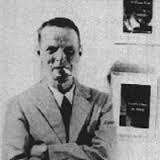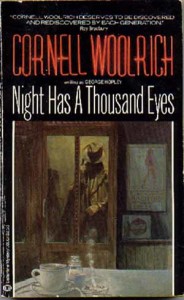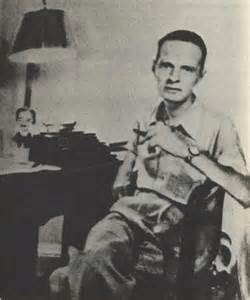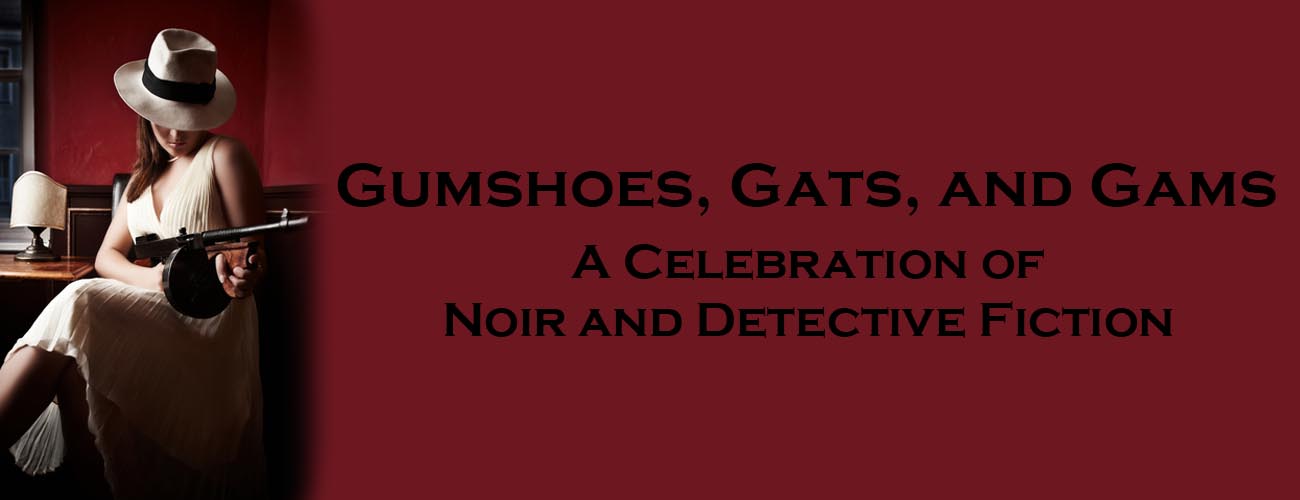 Mystery and suspense author Cornell Woolrich was born on this day (December 4) in 1903. He died in 1968.
Mystery and suspense author Cornell Woolrich was born on this day (December 4) in 1903. He died in 1968.
Although he started out in the 1920s writing jazz age stories in the vein of F. Scott Fitzgerald, he soon began writing stories of crime and suspense.
His work is characterized by protagonists who often feel as though they are at the mercy of forces beyond their control. In much of his work from the 1930s, the Depression was a major theme. Few writers were capable of ratcheting up the tension like Woolrich. He never wrote a sequel, so there was never a guarantee that any of the characters would survive until the end of the story, including the protagonist.
His most well-known novels were the “black” novels written in the 1940s and include The Bride Wore Black, The Black Curtain, Black Alibi, The Black Angel, The Black Path of Fear, and Rendezvous in Black.
Woolrich was a prolific short story writer, and a number of his stories have been collected. Many have also been adapted for film and radio. The best known of these is Rear Window, which was filmed by Alfred Hitchcock and starred Jimmy Stewart and Grace Kelly. He also wrote under the pen names William Irish and George Hopley.
 His best known work as Hopley was Night Has a Thousand Eyes, in which a rich man is told by a fortune teller that he will meet is death at the jaws of a lion. When a lion escapes from a circus, he hires a detective to protect him. The tension mounts as the millionaire, his beautiful daughter, and the detective wait in the isolated mansion. The roulette game they play is intense and high-stakes. (The million bets his daughter’s hand in marriage.)
His best known work as Hopley was Night Has a Thousand Eyes, in which a rich man is told by a fortune teller that he will meet is death at the jaws of a lion. When a lion escapes from a circus, he hires a detective to protect him. The tension mounts as the millionaire, his beautiful daughter, and the detective wait in the isolated mansion. The roulette game they play is intense and high-stakes. (The million bets his daughter’s hand in marriage.)
My favorite Woolrich novel, Phantom Lady, was published under the William Irish byline. In this novel, a man has a row with his wife and goes downstairs to have a drink at a bar and cool off. While there, he gets into a conversation with a woman he’s never seen before. Soon he tells her he has dinner reservations for two and tickets to a show. Since his wife won’t be accompanying him, he and the woman agree to have a night on the town. In order to avoid any future complications, they agree not to exchange names and to never try to contact or see each other again. So they go to dinner, see the show, and then go dancing for a bit, ending the evening by parting ways as they agreed to do. The man returns to his apartment to find his wife murdered. He’s the only suspect. Everyone who saw him that night swears he was alone. This woman is his only alibi, and he has no idea who she is or how to find her. The first chapter is titled “The Hundred and Fiftieth Day Before the Execution”. They count down from there.
Woolrich was a homosexual who lived most of his adult life with his mother and then alone after her death. He eventually became a recluse due to alcoholism and an amputated leg. Harlan Ellison claims he met Woolrich at a party in the 1960s, a party at which no one else saw Woolrich. This was the inspiration of his story “Tired Old Man.”
Much of Woolrich’s work has been out of print in recent years due to estate issues, but Centipede Press has begun reprinting some of his novels and stories with plans to reprint more.

Just so happens Hamilton has a couple of the Centipede paperbacks available…
Grab them. Phantom Lady is one of the entipede titles. Don’t know if it’s one of the Hamilton titles…
You had me with the dame in the fedora with a Thompson. I’m a sucker for a full-auto femme fatale.
Same here. I saw that picture and knew I had to have it. Fortunately I got it for a good price.
I’ve seen the picture of David Goodis at top used in a couple of places for Cornell Woolrich, but it’s not him. The picture at the bottom IS Woolrich, the one at the top is David Goodis, another great noir novelist whose work was adapted by Hollywood. It seems like you would have noticed they look nothing alike.
You are correct, sir. That is indeed David Goodis, and the picture was labeled Cornell Woolrich where I found it. I’ve replaced it with one of Woolrich. As to the pictures looking nothing alike, I attributed the difference appearances to be a combination of the difference in the ages of the two men and Woolrich’s poor health in his last years. I simply accepted the label on the first picture and assumed it was Woolrich when he was young and his health hadn’t deteriorated yet. Thanks for pointing out that it was Goodis. I’ve read one of his novels and quite liked it. I need to read some more.